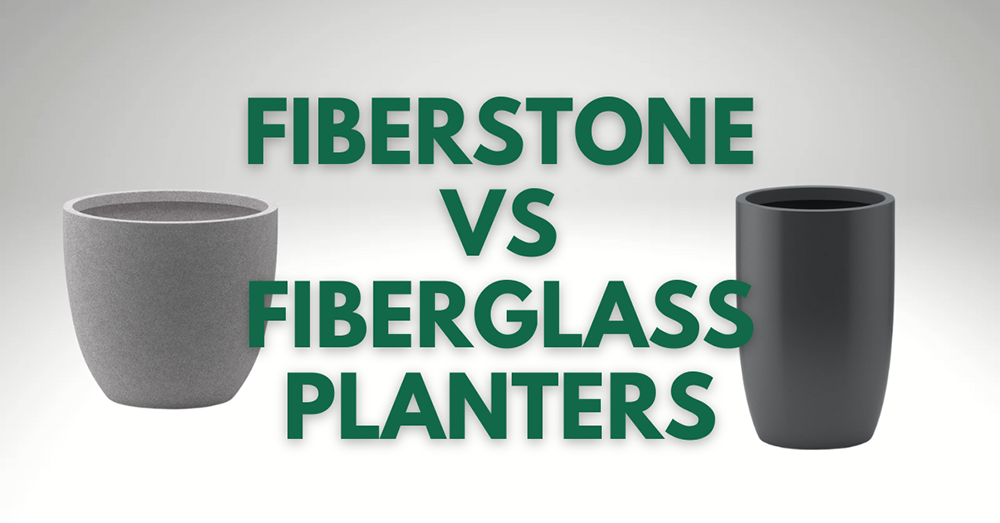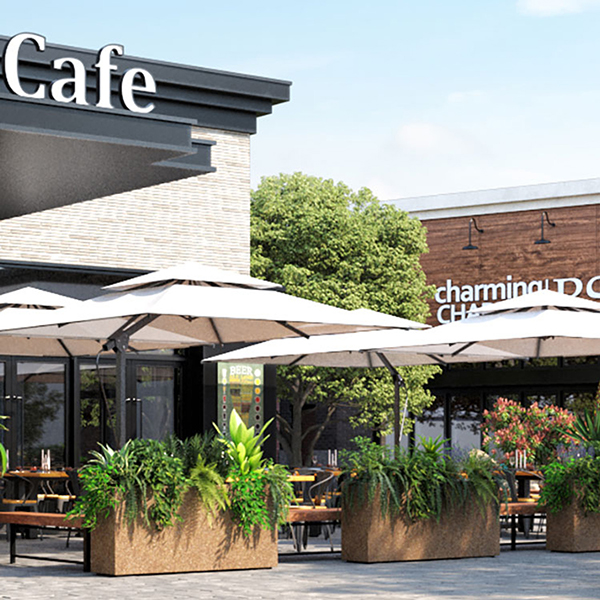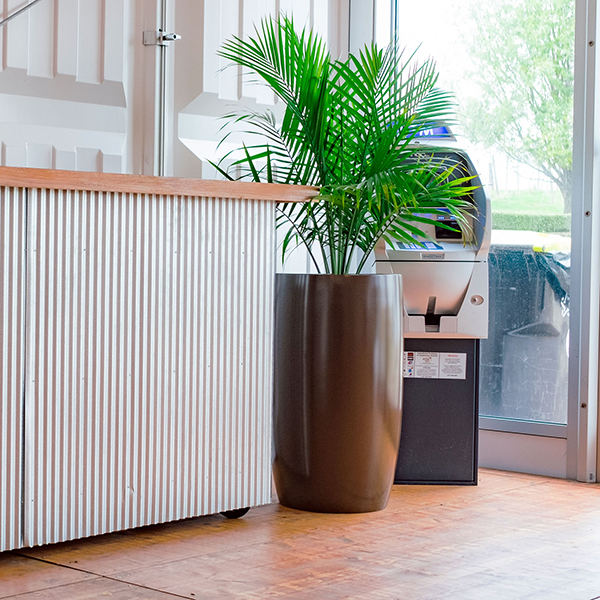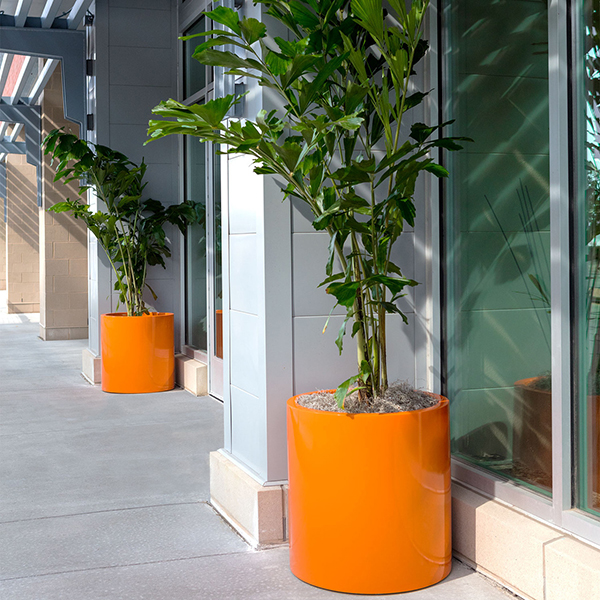Fiberstone vs. Fiberglass Planters: A Comparison Guide
Posted by Jason Wyrwicz on Jul 16th 2024

Ever stared at a sea of plant containers, feeling lost? You’re not alone; there’s an overwhelming array of materials out there.
In this article, we’ve narrowed it down to two excellent choices: Fiberstone and fiberglass planters. That makes things much easier, right?
You've just got to decide between these two modern contenders. They're both tough, look great, and can handle whatever Mother Nature throws at them. But each has its own unique strengths.
So, which one is right for you? Well, that depends on what you're after, but we're pretty sure you'll have a clear picture by the end of the article.
Key Highlights
What you'll learn:
- The composition and properties of fiberstone and fiberglass
- How each material stands up to weather and wear
- Weight considerations and ease of movement
- Best use cases for fiberstone and fiberglass planters
And more!
Quick Comparison of Fiberstone vs. Fiberglass Planters
Overview of Fiberstone Planters

Fiberstone is a composite material that brings together the best of both worlds: the look of stone and the practicality of modern materials. It's made by blending the stone powder with fiberglass and resin, resulting in a product that's both durable and surprisingly lightweight.
The Qualities of Fiberstone Planters
- Fiberstone mimics the texture and appearance of natural stone, giving your planters a classic, timeless look. It's available in a range of colors and finishes, from smooth to rough-hewn.
- These planters are built to last. They resist chipping, cracking, and fading, even when exposed to harsh weather conditions.
- While not as light as pure fiberglass, fiberstone planters are a lot lighter than their stone or concrete counterparts. So, this makes them easier to move and suitable for a wider range of locations.
- Fiberstone holds up well in cold climates, resisting frost damage and cracking during freeze-thaw cycles.
The material is treated to withstand sun exposure, maintaining its color and integrity over time.
Overview of Fiberglass Planters

Fiberglass planters are made from fine glass fiber woven into a cloth and then coated with a resin. This process creates a lightweight yet strong, highly versatile material.
The Qualities of Fiberglass Planters
- Fiberglass can be molded into virtually any shape or size, allowing for a wide range of design possibilities. It can also be finished to mimic other materials like stone, metal, or wood.
- Fiberglass planters are exceptionally lightweight, making them easy to move and ideal for applications where weight is a concern, such as planters for balconies or roof gardens.
- You might be under the impression that a fiberglass planter will be a little flimsy because of its lightweight, but they are surprisingly tough. They resist cracking, chipping, and corrosion.
- High-quality fiberglass planters stand up well to various weather conditions.
- Fiberglass plant pots and planters can be easily painted or finished in any color to match your space. ( At Pots, Planters, and More, our fiberglass and fiberstone planters are available in 50+ colors)
Differences Between Fiberstone and Fiberglass Planters

Rio Grande Modern Cylinder Planter Pot
Now that we've covered the basics, let's cut through the noise and focus on what really matters. These differences might seem subtle, but they'll be what matters when finding the planter that'll make your plants (and you) happiest.
Weight and Portability
This weight difference will dictate to an extent where you can use them. Fiberstone is great for ground-level gardens or sturdy balconies. As mentioned earlier, it is lighter than concrete or stone but still substantial enough for windy areas or locations where stability is important.
Its weight provides a sense of permanence and can anchor larger plants or trees that might topple lighter containers.
Fiberglass, however, is great for indoor spaces, delicate decking, or anywhere you might need to move plants frequently. It's particularly well-suited for office environments where layouts change often, restaurant patios that get rearranged seasonally, or home staging where portability is required.
Really anywhere the décor needs regular refreshing without much heavy lifting.
Durability and Weather Resistance
Regarding toughing it out against the elements, both fiberstone and fiberglass bring their A-game.
Fiberstone planters resist fading, chipping, and cracking like champs, even when Mother Nature throws her worst tantrums. The stone component gives it excellent thermal properties, helping to insulate plant roots against temperature extremes.
Fiberglass is no slouch, either. It's resilient and can take a beating without showing much wear. It won't rust or corrode, which makes it a great choice for coastal areas where salt air can be a problem.
Both materials can handle rain, snow, and wind. But if you're in an area prone to hail or falling branches, fiberstone might have a slight edge due to its denser composition.
For those in areas with dramatic temperature swings, fiberstone's ability to resist cracking during freeze-thaw cycles is a definite plus. Fiberglass is also freeze-resistant, but it may not provide as much insulation to plant roots in extreme cold.
With proper care, either type of planter can last for many years, potentially outliving several generations of plants.
In short, both materials are tough cookies—not indestructible. Treat them right, and they'll return the favor to keep your outdoor spaces looking sharp for years to come.
Aesthetic Appeal and Customization
Let's talk style. Fiberstone and fiberglass both bring something special to the table when it comes to looks.
Fiberstone is all about that natural stone vibe. It nails the look and feel of real stone, from smooth and polished to rough and weathered. If you're after planters that blend with natural landscapes or complement traditional architecture, fiberstone is well-suited.
When it comes to shapes, fiberglass has a bit of an edge. It can be molded into pretty much any form you can dream up. Fiberstone isn't as flexible, but it still offers plenty of options, especially in classic styles.
Texture? Both materials have it in spades. Fiberstone can give you that pitted, weathered stone look or go as smooth as marble. Fiberglass can be sleek or textured to feel like, well, almost anything.
If you're the type who likes to switch things up, fiberglass might be your best bet. It's easier to modify after purchase, so if you decide your planter needs a new look down the line, it's usually simpler with fiberglass.
Color-wise, you're spoiled for choice with both materials. Whether you're after earthy tones or something that pops, you'll find a shade that hits the spot. Remember, we've got over 50 colors to choose from in both materials.
Cost Considerations
Fiberstone planters typically carry a slightly higher price tag than fiberglass. This bump in cost reflects the unique blend of materials and the manufacturing process that gives fiberstone its stone-like qualities. You're paying for that authentic look and feel that's hard to distinguish from real stone.
While still in the premium category, fiberglass planters have a slightly lower price point. Both materials offer durability that pays off in the long run. These aren't your average planters that need replacing every other season.
Fiberstone and fiberglass are built to last, potentially saving you money over time compared to cheaper alternatives that wear out quickly.
Bear in mind the exact cost will vary depending on the size, design complexity, and finish of the planter.
Best Use Cases
We're not here to tell you where and how to use your planters - that's entirely up to you and your creativity. But we can certainly suggest some scenarios where each material might perform best.
Fiberstone planters are fantastic for:
- Large outdoor installations where you want the look of stone without the extreme weight
- High-traffic areas that need durable, stable planters
- Regions with extreme temperature fluctuations, thanks to their excellent insulation properties
- Commercial landscaping projects where longevity and low maintenance are required.
Fiberglass planters are recommended for:
- Indoor or outdoor spaces where lightweight materials are called for
- Areas that require uniquely shaped or oversized planters
- Locations where planters have to be moved frequently
Remember, these are just suggestions.
Final Thoughts
Well, there you have it - the lowdown on fiberstone and fiberglass planters.
Whichever you choose, you're in for a long-lasting, weather-beating planter that'll keep your greens happy for years.
So, what's it going to be? Fiberstone or fiberglass.
Why not check out our full selection and see what catches your eye?



